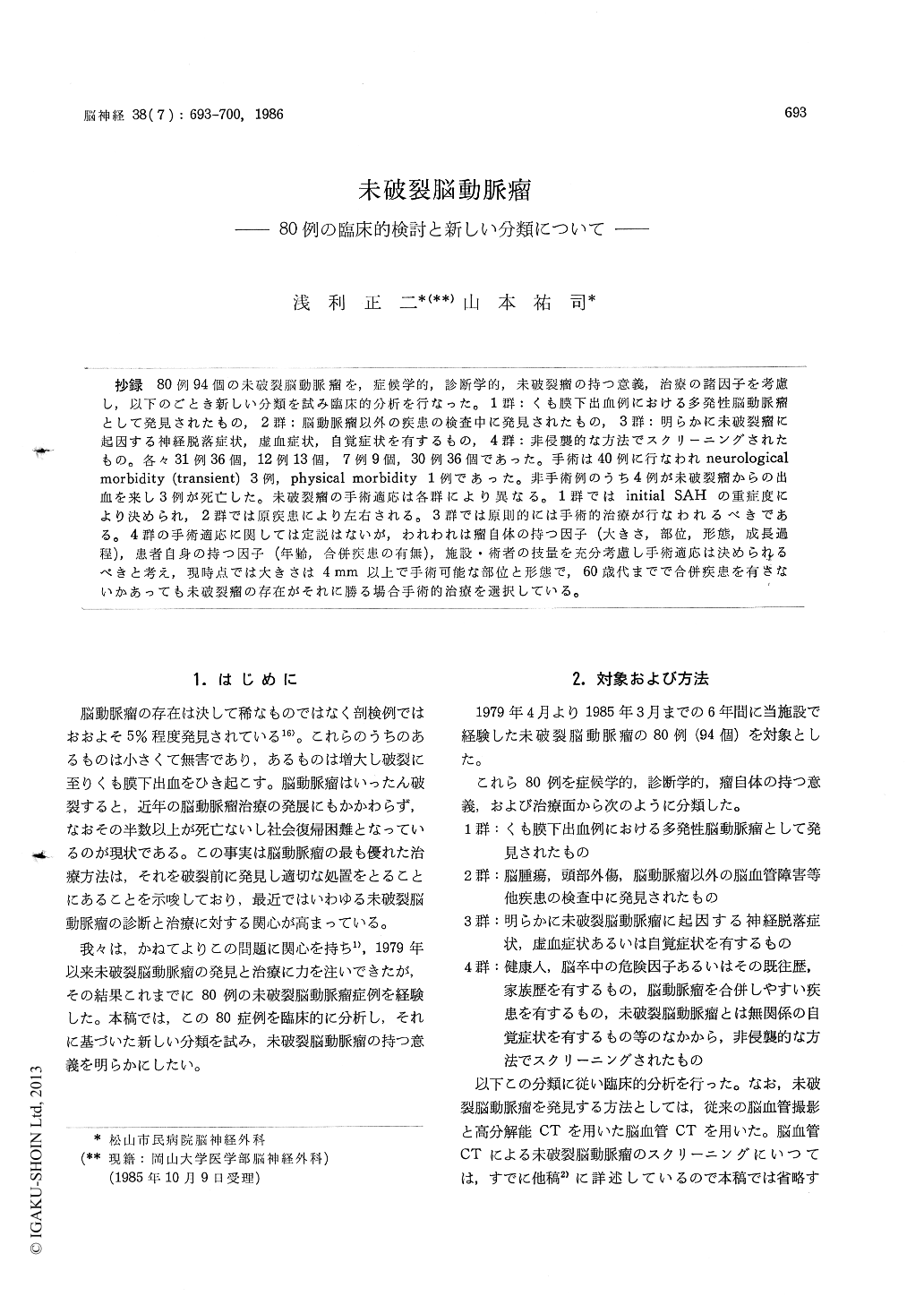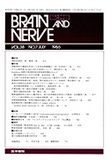Japanese
English
- 有料閲覧
- Abstract 文献概要
- 1ページ目 Look Inside
抄録 80例94個の未破裂脳動脈瘤を,症候学的,診断学的,未破裂瘤の持つ意義,治療の諸因子を考慮し,以下のごとき新しい分類を試み臨床的分析を行なった。1群:くも膜下出血例における多発性脳動脈瘤として発見されたもの,2群:脳動脈瘤以外の疾患の検査中に発見されたもの,3群:明らかに未破裂瘤に起因する神経脱落症状,虚血症状,自覚症状を有するもの,4群:非侵襲的な方法でスクリーニングされたもの。各々31例36個,12例13個,7例9個,30例36個であった。手術は40例に行なわれneurologicalmorbidity (transient)3例,physicalmorbidity1例であった。非手術例のうち4例が未破裂瘤からの出血を来し3例が死亡した。未破裂瘤の手術適応は各群により異なる。1群ではinitial SAHの重症度により決められ,2群では原疾患により左右される。3群では原則的には手術的治療が行なわれるべきである。4群の手術適応に関しては定説はないが,われわれは瘤自体の持つ因子(大きさ,部位,形態,成長過程),患者自身の持つ因子(年齢,合併疾患の有無),施設・術者の技量を充分考慮し手術適応は決められるべきと考え,現時点では大きさは4mm以上で手術可能な部位と形態で,60歳代までで合併疾患を有さないかあっても未破裂瘤の存在がそれに勝る場合手術的治療を選択している。
We experienced 94 unruptured cerebral aneu-rysms in 80 patients in our clinic between April 1979 and March 1985, and analyzed them in the light of the symptomatological factor, diagnostical factor, significance of aneurysm itself and its treat-ment. Based on these clinical analysis, unruptured cerebral aneurysms were classified into the follow-ing 4 groups; Group 1: intact aneurysm in multiple aneurysms in patients with subarachnoid hemor-rhage, Group 2: asymptomatic aneurysm discover-ed incidentally during the investigation of various diseases other than cerebral aneurysm, Group 3: symptomatic aneurysm with compression or ische-mic clinical signs, or subjective symptoms due to aneurysm, Group 4: asymptomatic aneurysm screen-ed by a noninvasive method in healthy humans, or in patients with a risk factor for cerebrovas-cular diseases, with diseases predisposed to aneu-rysm, and with minor subjective symptoms un-related to aneurysm. Group 1 included 36 aneu-rysms in 31 patients, with internal carotid aneu-rysms being predominant; the size of 3 mm was most frequently found and those smaller than 10 mm formed in 92%. An operation for aneurysm was performed in 17 patients without operative morbidity and mortality. Among 14 unoperated patients one died of hemorrhage from an unrup-tured cerebral aneurysm. Indication for operation in Group 1 is determined depending on the pa-tient's severity due to initial SAH. Group 2 was composed of 13 aneurysms in 12 patients; internal carotid aneurysm and anterior cerebral aneurysm, 5 each, being dominant. The size of 3 mm was most frequently seen and all were smaller than 7mm. An operation was performed in 5 patients all showing a favorable course. Indication for operation in Group 2 should be determined in the light of the underlying diseases. Group 3 included 9 aneurysms in 7 patients, with internal carotid aneurysms being predominant. Large aneurysms were outstanding. Although the course of 3 ope-rated patients was favorable, hemorrhage occur-red in 2 out of 4 unoperated patients and one died. Surgical treatment is to be considered principally in Group 3. Group 4 was composed of 36 aneu-rysms in 30 patients and middle cerebral and anterior cerebral aneurysms were predominant. The size of 5mm was found most frequently and sizes smaller than 10mm constituted 72%. An operation was carried out in 15 patients and tran-sient neurological morbidity was seen in 3 and permanent physical morbidity in 1. Of the 15 unoperated patients one died of hemorrhage from an unruptured aneurysm. Indication for operation in Group 4 should be determined, taking into consideration the factors of the aneurysm (size, location and shape), those of the patient (age and physical condition) and the skill of the surgeon.

Copyright © 1986, Igaku-Shoin Ltd. All rights reserved.


